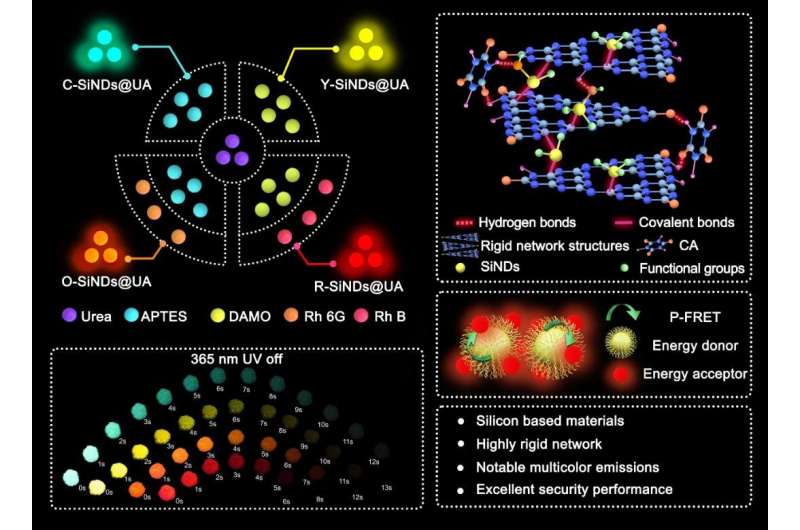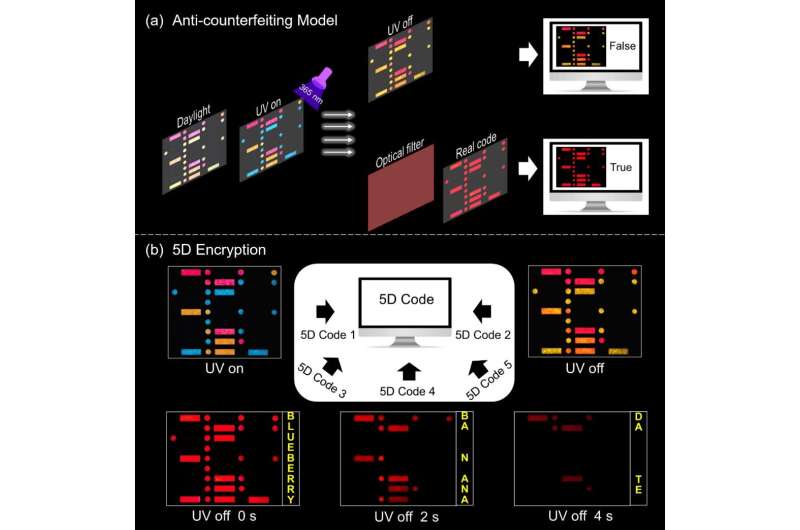
The application of photoluminescent materials in the field of information security has attracted much attention. A number of anti-counterfeiting technologies have been developed, including watermarks, 2D codes and luminescent printing. However, common fluorescent materials are monochromatic and easily counterfeited.
A team of researchers from the Suzhou Institute of Biomedical Engineering and Technology (SIBET) of the Chinese Academy of Sciences developed a nanocomposite material with multicolored afterglow using a simple hydrothermal method. They used silane as a precursor for the synthesis of Si-based phosphorescent materials and applied it in the field of information security. Their results were published in the Chemical Engineering Journal.
Room-temperature phosphorescence (RTP) materials have been widely used in bioimaging, information security, and lighting because of their distinctive afterglow properties.
“Conventional synthesis methods mainly use inorganic compounds containing rare earth ions or complexes with noble metals to provide afterglow, which inevitably leads to high biological toxicity and expensive syntheses,” said Dong Wenfei, lead researcher of the study.
Two requirements must be met, namely efficient exciplex intersystem crossing, and a stable rigid structure that stabilizes the excited triplet states of the exciplexes, according to Dong.

In view of this, the researchers selected 3-Aminopropyl triethoxysilane (APTES) and N-[3-(Trimethoxysilyl) propyl] ethylenediamine (DAMO) as Si sources, with urea added as another precursor, to produce optically stable cyan and yellow RTP materials, respectively.
The preparation process is a one-step hydrothermal method, which not only effectively avoids the disadvantages of the two-step method but also more conveniently forms nanodots in situ and immobilizes them in the matrix.
This newly developed anti-counterfeiting strategy can be applied to higher-level encryption scenarios where only interference information is obtained in the UV-irradiation and afterglow modes, and the assistance of a filter is required to accurately read the encrypted content, thereby enabling better concealment of the correct information.
“Given the universality of this method, this standardized strategy not only highlights the potential of constructing multifunctional phosphorescent materials from silane, but also provides a novel design principle for the synthesis of full-color afterglow materials,” said Dr. Zan Minghui, corresponding author of the study.
This study demonstrates the feasibility of using silane to synthesize multi-color phosphorescent materials and provides novel design principles and insights for the construction of silicon-based afterglow materials for innovative applications.
More information:
Yulu Liu et al, Multi-Color Room temperature phosphorescent Silicon-Nanodot-Based nanocomposites with silane tuning and applications to 5D information encryption, Chemical Engineering Journal (2023). DOI: 10.1016/j.cej.2023.144349
Provided by
Chinese Academy of Sciences
Citation:
Scientists develop novel multi-color room temperature phosphorescent silicon-nanodot-based nanocomposites (2023, July 5)
retrieved 5 July 2023
from https://phys.org/news/2023-07-scientists-multi-color-room-temperature-phosphorescent.html
This document is subject to copyright. Apart from any fair dealing for the purpose of private study or research, no
part may be reproduced without the written permission. The content is provided for information purposes only.









